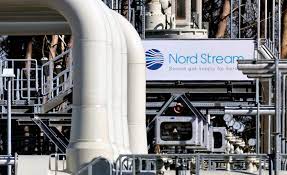After a 10-day maintenance closure, natural gas began flowing through a key pipeline from Russia to Europe on Thursday. However, the gas flow was still significantly below full capacity, and the forecast was uncertain, so Europe is still at risk of experiencing a harsh winter.
Since July 11 for yearly maintenance, the Nord Stream 1 pipeline under the Baltic Sea to Germany has been shut down. German officials had feared that the pipeline, the nation’s primary supply of Russian gas, which recently accounted for almost a third of Germany’s gas imports, might not reopen at all amid rising tensions over Russia’s war in Ukraine.
After 6 a.m., according to network data, gas started to flow through the Nord Stream 1 pipeline as planned, and the operator claimed to have “successfully completed all planned maintenance activities.” However, as they had been for weeks prior to the maintenance window, deliveries were still far below the pipeline’s maximum capacity.
Klaus Mueller, the head of Germany’s network regulator, reported that Russian company Gazprom had informed deliveries of around 30% of the pipeline’s capacity on Thursday. Later, he tweeted that real deliveries were higher than that figure and might even reach the pre-maintenance level of around 40%.
For Europe’s energy crisis to be solved, that would not be sufficient. According to Mueller, “the political instability and the 60% drop from mid-June unhappily remain.”
Last month, when Gazprom curtailed the flow, it cited purported technical issues with machinery that partner Siemens Energy had sent to Canada for maintenance but was unable to retrieve due to sanctions related to Russia’s invasion of Ukraine.
The turbine that drives a compressor station at the Russian end of the pipeline can now be shipped to Germany, according to approval from the Canadian government earlier this month.
The German government has repeatedly accused Gazprom of using a technical justification for the gas reduction as a cover for a political decision to create uncertainty and raise energy prices. The turbine, it claimed, was a replacement that was only intended to be placed in September, but it claims to be doing all in its power to strip Russia of the justification to reduce supplies.
Vladimir Putin, the president of Russia, stated on Tuesday that Gazprom still hadn’t received the necessary paperwork for the return of the turbine and on Wednesday he questioned the caliber of the repairs. According to Putin, if the turbine that was shipped to Canada wasn’t returned by late July when Gazprom was scheduled to shut down another turbine for maintenance, the flow of gas would further decrease.
Ursula von der Leyen, the head of the Executive Commission of the European Union, declared on Wednesday that there was “no reason not to distribute” gas since the turbine was “in transit.”
Energy policy specialist Simone Tagliapietra of the Bruegel think tank in Brussels claimed that Russia was engaged in a “strategic game.”
“Maintaining low flows is preferable to cutting off. It weakens Europe’s willingness to cut back on gas consumption, he claimed. He stated that since an interruption is expected to occur in the winter, Europe must nonetheless enter crisis mode. And every cubic meter of gas conserved now strengthens Europe’s resistance over the next months.
Even though there was a report that gas was flowing once more, German Foreign Minister Annalena Baerbock stated that “today highlights that this war is not only being conducted with weapons against Ukraine, but that hybrid warfare also involves utilizing energy dependency as a means of war.”
This week, the European Commission suggested that member nations reduce their gas use by 15% over the upcoming months as the EU braces for a potential cut of Russian gas supplies.
In order to lessen their reliance on Russian energy imports and fill gas storage tanks in time for the winter, Germany and the rest of Europe are frantically working. Gas is crucial to Germany’s economy since it powers its industry, provides heating, and to some extent produces electricity. Germany has the largest economy in Europe.
The government activated the second stage of Germany’s three-stage emergency natural gas supply plan last month, saying that the continent’s largest economy was in “crisis” and that winter storage goals were in jeopardy. Germany’s gas reserves were 65.1% full as of Wednesday.
The German government has authorized utility providers to restart 10 idle coal-fired power facilities and six idle oil-fired power plants in order to make up for deficiencies. 11 additional coal-fired power stations that were supposed to shut down in November will be permitted to continue functioning.

















